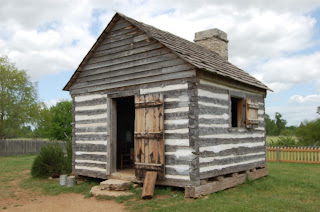Dr. Anson Jones arrived in Texas in 1833, settling in Brazoria where he set up a medical practice. He became involved in Texas politics and became president of the Republic of Texas (after it was independent of Mexico) and served one year until Texas became the 28th state in the Union at the end of 1845. Soon after his inauguration, the Jones family moved to the farm which Dr. Jones named Barrington after his home town in Massachusetts.
The home is the original structure built in 1844 and was moved to its present site. The outbuildings were recreated based on typical Texas architecture of the mid 19-century and information found in Dr. Jones' journals, diaries and account books. They represent the lifestyle of the Jones family and the slaves who lived and worked there.
View of house with smokehouse on left, kitchen next to house, (chicken coop behind smokehouse)
House showing porch and dogtrot, or open space to gather for work or play when weather permitted
Left front and back--master bedroom and back bedroom, right front and back--parlor, dining room
the upstairs consists of two large rooms
Hand-quilted, don't know if they are antique I liked this one because the leaves are stuffed then sewn shut so they are puffed above the rest of the quilt.
This is way more work than I want to do.
Kitchen--outside and
inside
barn, slave cabins, pigpen (far left)
inside slave cabin
left side of room
Herds of cattle came up from Mexico into Texas and mingled with cattle lost by eastern settlers. They adapted to the wide-open plains, and developed the wide sets of long horns characteristic of Texas Longhorns. Oxen are any breed of cattle that are four years old or older, have been trained to work while wearing a yoke, and provide the poser and strength to move heavy loads and cultivate farmland.
The hogs on the farm are descendants of Spanish pigs brought to the New World almost 500 years ago and look like the hogs of 19th century Texas. (Look like regular pigs to me!) The young pigs were allowed to roam freely during the spring and summer. In the fall the pigs were herded into the pen to fatten up for butchering as soon they were big enough.
After wandering around the farm for an hour or so, we made our way to the Museum.
Come with us to the Museum next.
Louise and Duane












1 comment:
This is a place right down our alley. We really enjoy visiting history.
I can't believe, Louise, that that quilt would be more work than what you would do. You do beautiful work!
Post a Comment